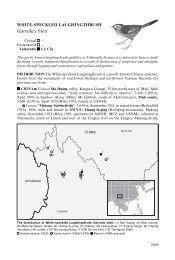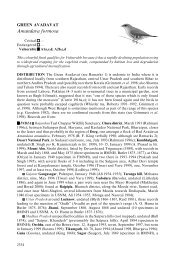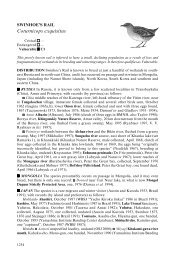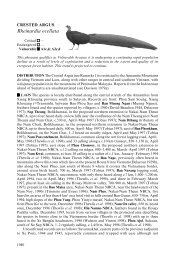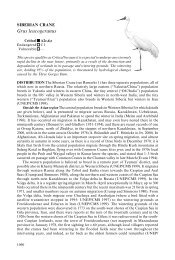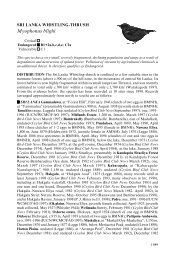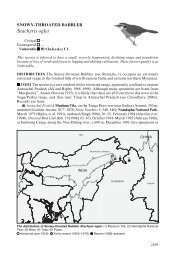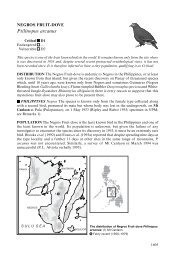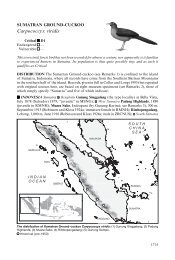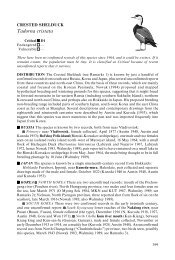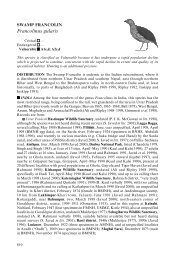Gyps bengalensis - BirdBase
Gyps bengalensis - BirdBase
Gyps bengalensis - BirdBase
You also want an ePaper? Increase the reach of your titles
YUMPU automatically turns print PDFs into web optimized ePapers that Google loves.
<strong>Gyps</strong> <strong>bengalensis</strong><br />
reported as high as 2,440 m and 3,100 m in the far east in March (Stevens 1912), and up to<br />
3,050 m at Khaptad in April–May (Inskipp 1988). Birds from the hills, and some from the<br />
Kathmandu valley, descend in winter; breeding has been recorded at Chitwan and in the<br />
Kathmandu valley (Inskipp and Inskipp 1991).<br />
However, at Koshi Tappu Wildlife Reserve one dead individual was found during a visit<br />
in 2000, and about 15–20% of individuals (presumably including, or mainly comprising, this<br />
species) were observed showing the head-drooping behaviour noted in India (see Threats:<br />
Disease); in Royal Chitwan National Park no vultures were seen (M. A. Virani in Rahmani<br />
and Prakash 2000b). Encouragingly, in Biratnagar in the south-east as many as 30 birds<br />
were seen in July 2000, although less happily only two were seen five months later in December<br />
(B. R. Subba per A. Mishra in litt. 2001).<br />
Bhutan The first records were three immatures in November 1991 at 150 m at Phuntsholing<br />
(Inskipp and Inskipp 1993a). In April 1993 it was again recorded at Phuntsholing, at 350 m,<br />
and in Royal Manas National Park at 250 m, and up to 10 individuals were seen at 1,200 m<br />
in the Harachhu valley (Inskipp and Inskipp 1993b). In March 1994 the species was found to<br />
be “notably common” around Phuntsholing (c.100 in total above the Teesta valley), slightly<br />
less so around Samdrup Jongkhar (in April 1995 and April 1996), with flocks of up to 50<br />
roosting; and smaller numbers were seen at 1,300 m at Deothang (Bishop 1999, K. D. Bishop<br />
in litt. 2000); but in May 1998 none was seen, in May 1999 fewer than eight, and in April–<br />
May 2000 none (K. D. Bishop in litt. 2000).<br />
Bangladesh The species was found to be common in the Lalmai area near Comilla during<br />
December 1944–July 1945 (Collins 1948), fairly common in all areas except the Chittagong<br />
hills (Mountford and Poore 1968), and the commonest vulture in Pabna district during 1968–<br />
1969 (Husain and Sarker 1971). In the Sundarbans region 340 individuals were estimated at<br />
four colonies during November 1981 and March 1983; populations density estimates in different<br />
areas ranged from 0.03 to 0.91 individuals per km 2 (Sarker 1987b). In the 1990s it was regarded<br />
as a common resident breeder in village areas (Thompson and Johnson 1996) and “locally<br />
common” throughout the country with flocks of 50–150 being seen on carcasses (Harvey 1990),<br />
e.g. individuals were recorded in a mixed-species flock of vultures east of Bhairab Bazar in<br />
February 1992 (Thompson et al. 1993). It was considered fairly common and widely distributed<br />
in all districts, especially in the plains and woodlands, but populations were decreasing “more<br />
rapidly than even a few years ago”; 40–50 regularly roosted at the Dhaka University campus<br />
in 1972, but only 4–5 in 1975, and none by 1979; about 150 frequented the suburbs of Dhaka,<br />
but did not breed; a colony of 20–25 bred at Aricha, “but their breeding success is very low”<br />
(Sarker 1983). Numbers are lower than in the 1980s and early 1990s, but the impression is<br />
certainly not of a dramatic collapse, rather a gradual process of deterioration (P. M. Thompson<br />
in litt. 2001). However, in Sylhet, near Maulvi Bazar, a group of 13–15 birds remained stable<br />
in the period November 1998–November 2000 (W. Collis in litt. 2000).<br />
Myanmar This species was once widespread (Walden 1876), being found throughout the<br />
plains but less often in the higher hills, except at Maymyo where it was more frequent (Smythies<br />
1986). It was apparently “often seen in great numbers, even in the suburbs of large towns”<br />
(Blyth 1875). Although it was “the common vulture” of the Shan States, it appeared to “leave<br />
the district in the rainy season” (Rippon 1901); it was “common throughout Tenasserim”,<br />
where “hundreds assembled round the carcasses of elephants and buffaloes” (Bingham 1880,<br />
Hume and Davison 1878). It was also common on the Sittang–Irrawaddy plain, breeding in<br />
Yangon (Rangoon) and Mingalun (Stanford and Ticehurst 1935a), fairly common in Minbu<br />
district during 1934–1937 (Roseveare 1952), common in Myingyan district (Macdonald 1906),<br />
and also common in Arakan in about 1910 (Hopwood 1912), but by the 1950s it was scarce<br />
there and appeared to be absent during May–October (Smythies 1986). Even over a century<br />
ago, although this species was “abundant” in Upper Pegu (Oates 1882) and Lower Pegu (Hume<br />
and Oates 1889–1890), E. W. Oates remarked (in Hume 1875a) that the birds never had<br />
601



